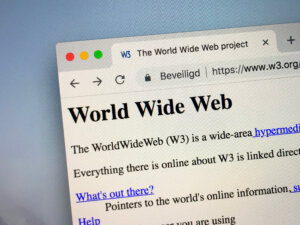The 100-year web domain – does anyone actually need one?

- WordPress has unveiled its new 100-year website domain plan
- It is for those seeking “longevity for their digital presence”
- But is it even possible for WordPress to keep its promises?
Have you ever wondered what will happen to your digital footprint after you die? Well, WordPress – the hosting titan used by 43 percent of all websites on the internet – has offered a solution: the theoretically immortal domain.
Last week, it announced its new ‘100-year plan,’ a website domain registration that lasts a century. The WordPress team will then become “guardians of your life’s work,” securing the site through multiple backups on separate data centers with 24/7 support.
It also promises “unmetered bandwidth, best-in-class speed, and unstoppable security,” which may raise some eyebrows given WordPress’s poor reputation when it comes to performance.
That being said, it remains the world’s most popular CMS, which may be why it feels it can charge $38,000 USD for its 100-year plan. But for such a large investment, and promise, the company has been strangely lax on details.
WordPress itself is only 20 years old, so it is bold to claim that it will be able to continue providing website support for a period five times its age. What if the domain name gets trademarked? What if WordPress goes bankrupt? What happens in the scenario of the “closing of WordPress to nuclear war,” as one commenter suggested?
A lot of information is still needed for this to not feel like a headline-grabbing stunt, though the plan will apparently be made available to those who register their interest in the plan.
The release indicates that the new plan is meant for three primary demographics: families, founders, and any individual who wants it. And has $38k to burn.
It pulls on the heartstrings of the former, being advertised as a way to “preserve their digital assets…for generations to come,” while, for the startup CEOs, it is a way to ensure they can continue showing off their achievements long after their company’s doors have closed.
The final group of interested individuals may be tempted by a “stable, flexible, and customized online home that can adapt to whatever changes the future of technology will bring”. This is also a bold statement, as the “future of technology” is famously a tricky beast to predict.
How we use websites and what we require of them has changed dramatically since they were made available for public registration in 1986.
A brief history of websites
Sir Tim Berners-Lee invented the web to enable information sharing between academics around the world. It was mainly used to distribute information, with text-heavy web pages primarily using HTML.
Over time, these became more visually appealing with the advent of other languages, like Java and CSS, and also started facilitating user interactions. This led to a dramatic change as sites that rely on user submissions, like YouTube and MySpace, and early social networking platforms that hosted users’ photos, videos, and text posts, like Facebook and Twitter, came into play.

The first ever website looks quite different to those of today, because we have different requirements of them. Source: Shutterstock
When smartphones became mainstream – and mobile internet surpassed that of desktop in 2016 – sites had to respond and become optimized for smaller touchscreens. Smart devices, like glasses, watches, and TVs, are only becoming more prominent too, and web developers need to respond to these changing trends for their sites to remain functional.
More recently, we have seen the rise of ‘Web 3.0,’ where technologies such as artificial intelligence (AI) and machine learning are integrated to enable a better understanding of online content. This allows for more sophisticated searches and personalized experiences for users, which could not be provided when relying solely on manual input and structured data.
A brief history of domain names
Domain names themselves are subject to similar trends and technology changes. The ’Domain Name System’ was invented in 1983 to reduce the complexity of remembering and typing in numerical addresses to access online information.
However, it was not long until the dawn of search engines and bookmarks meant it was no longer necessary to type in a full address to access a website. After that, the best domains were deemed to be long, filled with keywords, and had a recognizable ‘top-level domain’ like ‘.com’.
“If you don’t own the .com, you will forever have to talk about yourself by using the full extension of your domain name,” Paul Nicks, the vice president of aftermarket sales at GoDaddy, told Protocol in 2021. While this may be true, it is not necessarily a negative.

While ‘.com’ still is the most popular top-level domain, modern companies now opt to incorporate unique ones, like ‘.xyz’ or ‘.ly’, into their brands. Source: Shutterstock
In 2011, the number of available top-level domains was expanded from 22 to thousands, and many brands took advantage of them. Cash.app is a good example, as well as musical.ly, a video-sharing app that is now TikTok. Brands that use one of these top-level domains tend to be newer, with ‘.ai’ particularly popular, therefore they have become a hallmark of innovation and modernity.
They can also easily be picked up by voice assistants, which have only become prominent in the last decade. Google owns ‘doc.new’ and ‘pdf.new’ as commands to open new Google Docs and PDFs, as certain top-level domains are becoming increasingly used to accomplish tasks rather than open specific websites.
The domain name registrar market is expected to reach $1,025 million in just four years due to the demand for a memorable online presence. With the constant changes, it would be difficult to be sure that a domain name picked today will be relevant and useful in the year 2123. Certain pockets of the internet maintain that decentralized domains, based on blockchain, will become the mainstream.
InMemoriam.com
WordPress’s new offering isn’t just about maintaining a brand, as “gifting [it] to a newborn” or other loved ones are also listed as potential uses. The website could become a showreel of one’s life to help others remember your favorite songs, photos, TikTok videos, and whatever other digital tools that draw you and your data in over your lifetime.
Morbid as it may be, many tech companies have been thinking about ways to preserve our digital footprints after we die, for those of us who have spent our lives online. Facebook and Apple allow you to assign a ‘legacy contact’ who can access your accounts and devices after your death. But this is a small-scale solution compared to what others are working on.
Last year, a dead woman ‘appeared’ at her own funeral to answer questions from mourners via technology from StoryFile. Before her death, Marina Smith was recorded answering over 100 questions and the footage was used to train an AI. This resulted in a film that can respond to natural language queries and preserve their likeness.

Marina Smith speaks at her own funeral via StoryFile technology. Source: StoryFile/Marina H. Smith Foundation
HereAfter AI does a similar thing but over voice only. Users record a series of vocal responses to prompts that appear like a chatbot, attaching related photos and videos as they go. Then, loved ones can download the app, ask the deceased questions, and receive an audio response from them.
YOV (You, Only Virtual) collects and analyses data from sources such as text messages, emails, voice recordings, and video chats to train a personalized chatbot that responds to the user exactly as their loved one would have when alive. This reduces instances of robotic-sounding, generic responses.
While some argue that these kinds of technologies do not actually lessen grief and only provide the illusion of connection, it is not out of the question that something similar will become mainstream in the future. There is the potential that a legacy WordPress site could host this kind of technology, with a sentimental URL chosen by the subject themselves. However, there is also a chance it will seem redundant compared to, say, a VR avatar trained on 100 years of online data.
Expiration dates
Despite WordPress’s promises, there is also no guarantee that a late friend or family member’s website, or any kind of digital space, will last a century. Files become corrupted, servers fail, and platforms shut down over time, working to degrade one’s online footprint.
The Permanent Legacy Foundation is a non-profit that stores people’s data in an encrypted vault and converts files to relevant formats over time for $10 per gigabyte. Its intention is to preserve digital artifacts and memories and address the potential loss of valuable information and personal history over extended periods.
Depending on the amount of data you want to store, this could end up being significantly more cost-effective than WordPress’s plan. Permanent invests the one-time payment from its customers, and the annual interest generated covers the cost of the multi-cloud storage.
Another method of storing data securely for a long time is utilizing blockchain technology and distributed ledgers. This decentralized approach spreads the data across a network of computers, making it resistant to tampering and maintaining data integrity. WordPress has yet to reveal how exactly it will guarantee the website’s security over such a long period.

WordPress is the world’s most popular CMS, which may be why it feels it can charge $38,000 USD for its 100-year plan. Source: Shutterstock
READ NEXT

Malvertising – a new corruption
Even if the site survives, a business linked to it may not have the same fate. Research from Innosight found that the average lifespan of an S&P 500 company in 1958 was 61 years, but this reduced to 24 by 2016 and is predicted to reach 12 in 2027.
This decline is due to a combination of factors, including technological advancements, increased market competition, changing consumer preferences, and disruptive startups. Saying that, only two in ten startups survive their first year, while around 90 percent fail at some point. This means that optimistic business owners may end up harboring an archive of their marketing materials when the 100 years is up.
But there are plenty of businesses older than a century, including tech companies like IBM, General Electric, Siemens, and BT. However, the majority of these operate very differently in 2023 from how they did at their inception. There’s no saying that a website will remain an accurate or positive representation of the brand if it does survive to see the end of the domain registration plan.
This again begs the question of how WordPress plans to maintain the site over the course of the century, considering it is largely built on PHP, a language that is quickly dropping in popularity. Whether the web itself makes it until 2023, and whether anyone even remembers WordPress’s promises, remains to be seen.
Maybe that’s exactly what it’s banking on.
WordPress has been contacted for comment.









